How to Select Your Touring Bicycle Gearing
Touring bicycle gearing is really not a complicated subject. Many factors do contribute to your speed as you ride on different terrain: which gear combination you are using; your pedaling cadence; and your wheel/tire size. But I am going to make this less technical so most people can understand without too much background information.

First, you must know how you are going to use the bicycle. Just because the bike store or manufacturer says that the model is a ‘touring’ bicycle, doesn’t mean that gearing will be right for you. Their idea of touring may differ from your idea. You may think about going out on unsupported tours, while the manufacturer designed the bicycle for lightly loaded tours and short mileage. Some touring models may have rack braze-ons, but the chainstays are too short for loaded panniers. And all too often, the gearing cannot handle loaded bicycle going up hills all day.
Most manufacturer do not believe that you are going to actually load the bicycle up with 60 lbs. of gear and ride off for 500 miles. That doesn’t mean that the bicycle will break down on your tour. I am only saying that you need to question the stock gearing before you hit the road.
Front Crankset and Rear Cassette Selection
You have a large variety of front cranksets to choose for the modern bicycle. In addition, the rear cogs or cassette can be 7, 8, 9, and 10 speeds to give you up to 30 different gears on a derailleur bicycle. However, most touring and mountain bicycles use a ‘triple’ front crankset and 8 or 9 rear cogs to give you 24 to 27 different touring bicycle gearing.
The rear cogs or cassettes that are suitable for touring bicycles usually have a 12 tooth smallest cog for 8 speed systems or 11 tooth for 9 speed systems. For your lower touring gear, the largest cog should be either 28, 32, or 34 teeth. The number of teeth of the intermediate gears will be between your smallest and largest cogs to give you fairly spaced gear inches. So with a triple crankset system, you will have 24 or 27 different gear inches. Unfortunately, touring bicycle gearing may not be 24 or 27 different usable gears due to some overlaps, which is common.
If you change the front crankset, you need to check your derailleur compatability with the new unit. Most front derailleurs are either double or triple crankset compatable and not both. Also, the difference in the number of teeth between the chainrings must be in the front derailleur’s range. Most mountain type of front derailleurs handle up to a 12 tooth between individual chainrings (e.g., 48 to 36 equals 12 teeth) and up to a 22 tooth between largest to smallest chainrings (e.g., 48 to 26 equals 22 teeth).
When it comes to changing out your rear cassette, most long cage derailleurs should be able to handle up to a 34 tooth cog. Short cage derailleurs that are used on racing and sport bicycles will only handle up to a 26 to 28 tooth rear cog. The long cage derailleur can handle the chain slack from going from the largest front chainring to the smallest front chainring.
Some of the common front cranksets available for touring bicycles include:
- Compact double: 50/34
- Road triple: 50/39/30
- Touring triple: 48/36/26
- Expedition triple: 44/32/22
- Mountain triple: 42/32/22
Variations of these sizes are quite common. Each manufacturer may offer these or other sizes as a complete set or individual chainrings.
What Are Gear Inches
Here is the most technical aspect I am going hit you with about touring bicycle gearing: When you are using one of your front chainrings and shift to one of your rear cogs, you are changing the ‘gear inches’ of your rear wheel. The higher the gear inches, then the harder it will be to pedal. If you keep the same pedaling cadence, a higher gear inch will make you go faster. It is the reverse for lowering the gear inches. If you are going up a steep hill, then you shift to a lower gear and thus lowering your gear inches. The result is easier pedaling up the hill.
Consequently, if you are just riding your bicycle without any load, you can pedal a higher gear (thus a higher gear inch) and don’t need such a lower gear (thus a lower gear inch). If you load up the bicycle and ride up hills, you will need more lower gears and not so high a gear.
Below are suggested high and low gear inches for different types of touring:
(For ease of discussion here, I am going to assume that your bicycle touring will be over flat and hilly terrain, high mileage over multiple days, and a variety of calm and windy conditions.)
- No load: High-125″, Low-30″
- Light load with or without sag wagon: High-115″, Low-28″
- Medium load with or without sag wagon: High-110″,Low-25″
- Heavy load without sag wagon: High-108″,Low-22″
- Heavy load with camping: High-100″,Low-18″
- Extra heavy load, expedition: High-100″,Low-16″
- Heavy load, mountain bike: High-98″,Low-16″
Crankset/Cassette Gear Inches
The following tables compare the different touring cranksets with different rear cassettes. Each crankset system in conjunction with the different rear cassettes and either 700c or 26″ wheels will result in the calculated gear inches as shown.
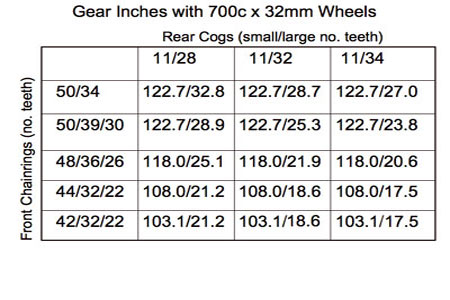
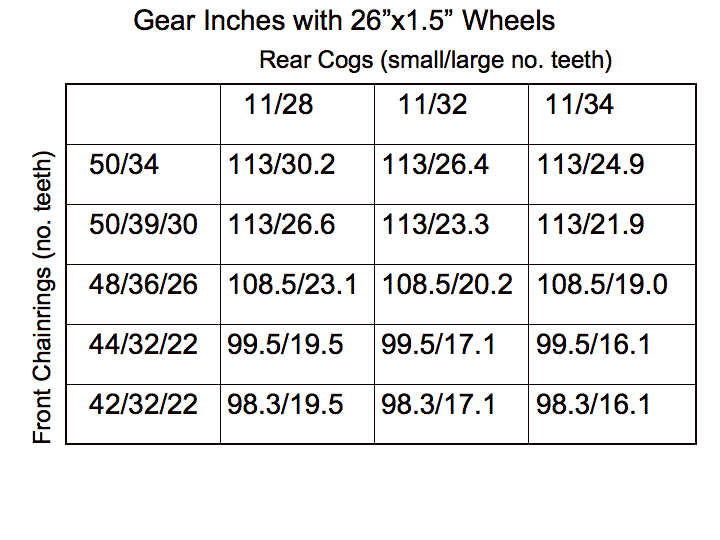
If you know your wheel size (e.g., 26″ or 700c), rear cassette gear sizes (e.g., 11 – 32 teeth), and front chain ring sizes (e.g., 48/36/26 teeth), the gear inches for your bicycle can easily be calculated. Sheldon’s Brown gear inch calculator is a wonderful site that will allow you to calculate gear inches and ratios.
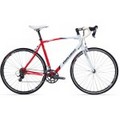
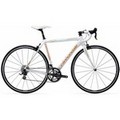
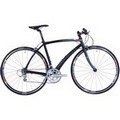

what do you consider to be light, medium and heavy loads?
Hi Bill,
Leanne here.
This is a great question. Your load size will always depend on your route, your touring style and the duration of your tour. A light load should be less than 20lbs, a medium load should be between 20lbs and 60lbs, and a heavy load should be more than 60lbs. For long tours, it’s difficult to go light, and most experienced young cyclists find themselves at the high end of the medium range.
I hope this helps!
Leanne is correct. I have travelled many a mile with loaded touring bags both front and rear, and unless you are prepared to spend what I consider to be a rediculous amount money on the most light weight equipment you can find, fully loaded touring with every thing I take doing double duty usually tops out for me at about 50lbs.
I am considering substituting the original 48/36/26 chainring set with a 44/32/22 on my LHT. I find that I have never wished for a higher gear and almost never use the 48/11 combination. I have found myself wishing for a lower gear than the 26/36 when fully loaded. What do you think? For me, when fully loaded the 48/36/26 just seems to high!
Thank you. I appreciate your time and your input.
I’ve done some light touring years ago, but want to get back into it now 35 years later. I’m in the process and buying a bike for touring now and hope to find a lightweight modern bike that can handle all serious touring asks of it … strength, ability to attach both rear AND front panniers and a triple crank to help this old dude up the mountains I plan to traverse.
I like a cyclo-cross model I saw … Cannondale CaadX Ultegra, but I Know it only has a double crank .. 50 / 34 I belive, and am unsure of front pannier abilities and nervous about wheel stregtgh.
As you may see, I know what I want, but I know that I DON’T know .. which is why I ask ……. can you help an old man up a hill please??
Thanks
Gerry 2.0
Are you still looking for that perfect lightweight touring bike? Is a 54cm your size? I have a Van Nicholas titanium touring bike for sale. Pretty much the ultimate touring machine in all respects. It’s set up with Shimano 105 triple. Gorgeous, versatile, light, and titanium is the most comfortable material to ride for long distances. I’m asking for best offers on $1500, which for a $4000+ bike is a steal.
Cheers.
Hmmm, no mention of half step gearing. For expedition, I’ve used 44/40/24 on a 11/34 freewheel. For nominal rides, including the Baldy loop, I’ve also used 50/45/24 on an 11/34. The close ratio on the chainrings means you generally change your front derailleur to shift, which puts you up or down half the ratio change of the rear derailleur shift. If you need more, then you can either go straight to the rear derailleur or do both.
And just a word on touring bike selection. A touring bike is supposed to be your best friend, next to your dog. It takes care of you on the road. It’s docile, comfortable, predictable, durable, versatile, and will carry all your stuff without complaining. Think of being on a tour and catching a heavy cold. You still need to ride, so you will want a bike that pretty much rides itself and takes care of you, even in weather. Oh, and lastly, remember that most bike shops don’t speak touring bikes. In fact, the normally don’t understand them at all. Do your homework on the internet and in the saddle. Find what works for you on local rides before embarking on a long distance ride. Bike shops can help, but you have to know what you want before going to them. al
Hi – I have a Miyata 1000LT frame – asking if it is worth building out for tours or getting a modern bike – such as a Surley, etc.
I’m an older rider, been riding lugged steel bikes for many years and do enjoy the way steel feels.
Any advice welcomed.
What did you end up going with? I have an old Miyata 910 and I was thinking about outfitting it for some light touring.
Thank you for the auspicious writeup. It in truth used to be a enjoyment account it.
Glance complicated to far added agreeable from you! By the way, how can we keep in touch?
This is really interesting, You are a very skilled blogger.
I’ve joined your rss feed and look forward to seeking more of
your fantastic post. Also, I’ve shared your web site in my social
networks!
Hi there to all, it’s genuinely a good for me to
pay a quick visit this website, it consists of priceless Information.